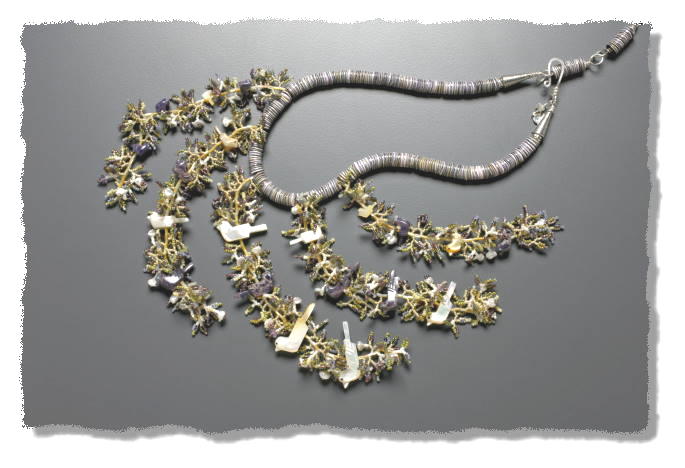When Daryl Shack, Sr. offered me this set of twenty rainbirds, I could see from his photo how exquisitely beautiful they are. Ten are of Mother of Pearl with black inlaid eyes, ten of a purplish material called Dumortierite with eyes of Turquoise. I felt very honored that he offered them to me, but also felt a great deal of trepidation about using them. I always want to use carvings in a respectful and attractive way that does not copy traditional forms. In this case, it seemed very important to provide an environment that would shelter the birds so they can feel happy. When I got them I was stunned, as you will be, by the masterful carving and exquisite polish of even the tiniest ½" long birds. Can you imagine making inlaid eyes for such minute creatures?
So now the piece is made, Melinda has taken a beautiful photograph, and all that is left is to describe these carvings to you. You probably already know that the Zuni people have long used fetishes. Anthropologists tell us that the earliest ones were rough stones which bore some resemblance to the animal. They tell us that over time, the people gradually started to modify the stones to enhance the resemblance. Some carvers, including Daryl, still recognize animals in the stone and sometimes make only the most minimal modification to the stone. More often Daryl executes a beautiful and fully realized carving as is the case with these birds. (Note that there is a distinction between a "carving" which is an art object available for sale and a "fetish" which, as I understand it, has been blessed by a Zuni priest and is used for ceremonial and religious purposes. The pieces on my web site are "carvings" not "fetishes.")
Many traditions make associations between particular animals and human traits, and you have read many quotes about these associations on these pages. Generally though, there isn't that much information about how the Zuni people themselves regard particular animals. McManis' text (see below) is about as close as we have, unless we are fortunate enough to know a person who lives the Zuni tradition and is willing to share some of it with us. So when I came to write this little essay, I naturally began with McManis but could not find a word about rainbirds. The old Frank Cushing text doesn't mention them either. The Medicine Cards provide a sort of generic Native American view about various animals but again, there is nothing about a rainbird. This seemed baffling because of the importance of rain to the Zuni people for their very survival and the centrality of rain ceremonies in some of their religious practices. It seemed to me the "rainbird" must have something to do with all this. Google gave a zillion pages depicting rainbirds on pottery, etc., but I couldn't find anything helpful about what a rainbird is or what it might mean. So finally I asked Daryl for any information he would be willing to share. Here's what he said:
"I'd like for you to mention that two bird deities called Su:Dickie are my influence in coming up with this unique creation. I fast every year for four days to pray and meditate for rain, hence rain birds. There are a couple of times out of the year when we make offerings to these beings. I know that Mr. McManis does not know everything... I think it takes a Zuni involved in our Culture, Traditions, and Religion to make sense of all of this. But in no way am I saying that these are representations of the Su:Dickie. I only say they are my influence."Looking at the materials, mother of pearl is the shell lining from which pearls can grow. There is a traditional East Indian association between pearls and rain-- Johari mentions that tantriks [sic] believe that when Svati Nakshatra rain comes to earth it produces pearl in pearl oysters. Likewise Pliny the Elder wrote,
"When the genial season of the year exercises its influence on the animal, it is said that, yawning, as it were, it opens its shell, and so receives a kind of dew, by means of which it becomes impregnated; and that at length it gives birth, after many struggles, to the burden of its shell, in the shape of pearls, which vary according to the quality of the dew." (Historia Naturalis 9:54, quoted in Pearls).
Dumortierite is rather less well known. The Peterson Field Guide mentions that it is found in many places in the world and notes that some found in Alpine, CA-- just a few miles from my home--exhibits a purple fluorescence. I need a black light to check these birds! In The Book of Stones Naisha Ahsian mentions dumortierite is a Wind element ally (so is perfect for birds) and that its energy stimulates one's higher mind and visionary abilities. Robert Simmons mentions that dumortierite opens the doors of insight, activating the third eye and assisting one in transcending intractable difficulties. Perhaps this little flock left it to the dumortierite birds to open the doors of my insight so I could see how they wanted me to make this necklace, I hope I got it.
I do hope you will order these beautiful birds and enjoy their gentle power and great beauty.







